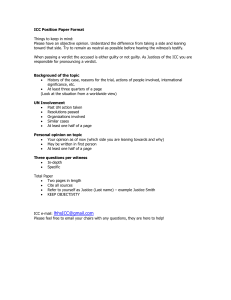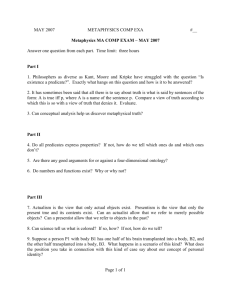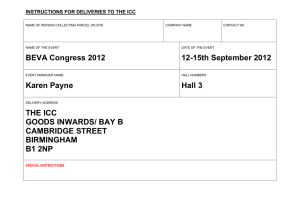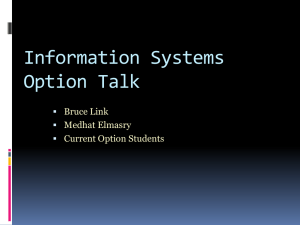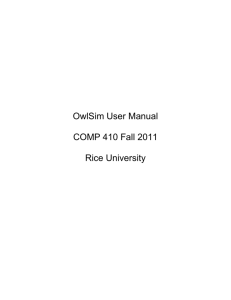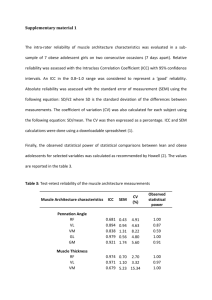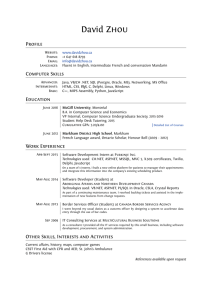Teacher Classroom Management Practices: Effects on Disruptive or
advertisement
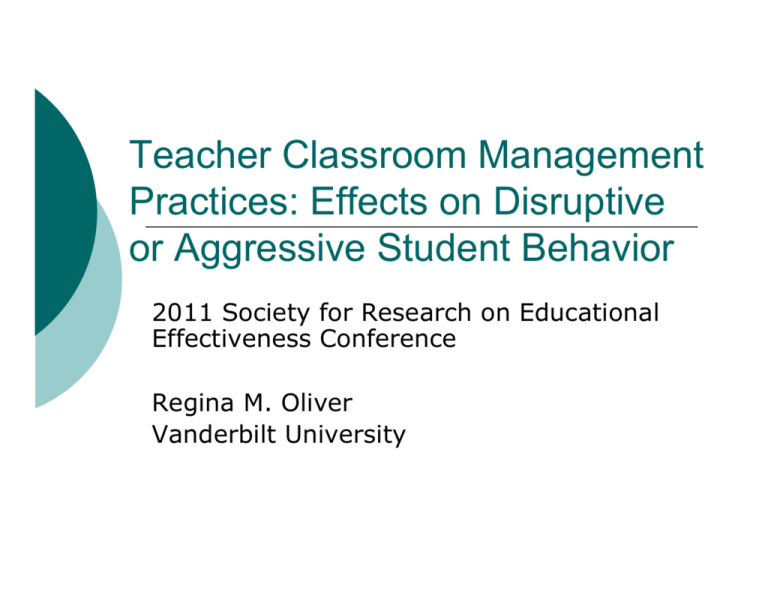
Teacher Classroom Management Practices: Effects on Disruptive or Aggressive Student Behavior 2011 Society for Research on Educational Effecti eness Conference Effectiveness Confe ence Regina M. Oliver Vanderbilt University A k Acknowledgements l d t Co-Authors Joseph H. Wehby, Vanderbilt University D i l J. Daniel J Reschly, R hl Vanderbilt V d bil University U i i S Special i l Th Thanks k to t Mark Lipsey Obj ti Objectives off Review R i Examine the effects of teachers teachers’ universal classroom management practices to reduce disruptive, aggressive behavior Greater understanding of what teachers can expect with use of combined effective classroom management practices— “Bang g for the Buck” What does it look like? R Research hQ Questions ti 1 1. 2. 3. 4. Do teachers’ teachers universal classroom management practices reduce problem behavior in classroom with students in K-12? What components make up the most effective and efficient classroom management programs? Do differences exist between grade levels in effects and classroom management components? Does treatment fidelity affect the outcomes observed? Method Meta-analysis was used to systematically identify the magnitude and direction of effects across studies and to determine what particular features of studies contribute to these effects. D fi iti Definition “A collection off classroom procedures implemented by teachers in classroom settings with all students, for purposes of preventing and reducing inappropriate behavior as well as teaching a g prosocial p o o a behavior” b a o Does not include social skills programs p g alone or academic instructional procedures I l i C Inclusion Criteria it i 1. 2. 3 3. The intervention Th i t ti mustt b be d delivered li d universally to all subjects. Pull-out or small group interventions (e.g., small group social skills) were not eligible. Interventions that began treatment outside of the classroom and then transferred it into the classroom were not eligible. Additional treatment components (e.g., (e g parent training) were allowed provided there was at least one outcome variable measuring i ttreatment t t effects ff t with ith students. I l i C Inclusion Criteria it i C Continued ti d Children in grades K-12 General or special education setting No Pre-K Residential, clinic, or day treatment settings not included Must have dependent measure of inappropriate student behavior in the classroom I l i C Inclusion Criteria it i C Continued ti d Experimental or quasi-experimental with control group Random d assignment, matching, h ANCOVA, or report pre-test—posttest data Post-test only, non-equivalent comparisons not included Single subject studies NOT included S Search hP Procedures d Database Search: Terms used: classroom management, classroom organization, classroom l structure, t t b behavior, h i outcomes, t evaluation, l ti effects, environment, climate, structure Author search: PsychoINFO, ERIC, ProQuest, ProQuest Dissertations Brophy, Evertson, Canter, Kounin, Kellam, van Lier Emailed Carolyn Evertson Website search: www.comp.org Hand search: Journal of Educational Psychology Journal of Applied Developmental Psychology Behavioral Disorders S l ti off Studies Selection St di IInitial i i l search h produced d d 5,134 5 134 titles il 94 abstracts reviewed 25 selected and screened Screening reliability was conducted on 100% with 96% average agreement. 12 studies selected for final inclusion Coding gp protocol used to extract data w// 84% point-by-point inter-rater agreement and discrepancies re-coded Classroom Organization and Management Program COMP Evertson et al., 1988 7 Studies S di Organizing the classroom Planning and teaching rules and procedures Managing student work and improving student accountability Maintaining good student behavior Planning and organizing Conduction of instruction and maintaining momentum Getting the year off to a good start Additional Research Question Added: Is there a significant difference in effects between COMP and Non-COMP Studies? “G d B “Good Behavior h i G Game”” 3 Studies St di (Ialongo et al., 1993; Dolan et al., 1999; van Lier et al., 2004) Group contingency used as universal classroom management Class split into teams Classroom rules Reinforcement f and d consequences Ialongo et al. also had parent training component p Dolan et al. had additional treatment group for Mastery Learning (not analyzed) M lti Multi-component t 2 Studies S di Proactive classroom management strategies (Hawkins et al., 1991) Frequent use of encouragement and praise ICPS social skills curriculum Interactive teaching (2nd grade only) Parent training School, classroom and parent components (Gottfredson et al al., 1993) Teachers trained in classroom management based on Evertson’s work St ti ti l P Statistical Procedures d Standard St d d mean difference diff effect ff t sizes calculated on dependent measures of disruptive, disruptive inappropriate, or aggressive student behavior in the classroom CMA and SPSS software used for the analysis I Intermediate di calculations l l i d done iin Excel Adj t Adjustments t Group combination (n = 2) Pretest adjustment (n = 2) Covariate adjustment (n = 1) Issue: u nested d data da a Issues: COMP studies t di reported t d classroom l measures as a mean Other studies reported individual students measures as a mean Need to have equivalent effect sizes across studies Non-COMP studies should be adjusted to classroom level Clustering Adjustment—Non COMP Studies (N = 5) Effect ff sizes based on individual student measures adjusted to classroom level effect sizes to have equivalent effect sizes with COMP studies ICC = .05 and ICC = .10 used in calculation and both reported ESclusteradj l t dj = ES sm .05 ES sm ESclusteradj = .10 “Standard Difference Between the Mean Classroom Effect Size” Effect ff sizes in final f analysis would not be typical ESsm Finall effect ff sizes would ld b be classroom level and larger than typical ESsm due to smaller standard deviations at classroom level Can not be compared with ESsm RESULTS Results Research Question 1: 1. Do teachers’ universal classroom management practices reduce problem bl b behavior h i iin classroom l with ih students in K-12? M i Eff Main Effects t Analysis A l i ESclassroom SE z p ICC ESsm .80 0.15 ( 05 0.74) (-.05– 0 74) 5.44 0.00 .05 .18 .71 71 0 13 0.13 (-.03–1.56) 5 53 5.53 0 00 0.00 .10 10 .22 22 A l Analyses C Continued ti d Sensitivity analysis in CMA did not indicate any one study had a greater impact on results “Trim and fill” procedure in CMA indicated no publication bias R Research hQ Questions ti 2 2, 3 3, & 4 4: • • • What components make up the most effective and efficient classroom management programs? Do differences exist between grade levels in effects and classroom management components? Does treatment fidelity affect the outcomes observed? H t Heterogeneity it Analysis A l i Q df p I2 ICC 13.72 11 0.25 19.83 .05 10 67 10.67 11 0 47 0.47 0 00 0.00 .10 10 M d t Analysis Moderator A l i Heterogeneity Analysis did not support moderator analysis Studies d d did d not report sufficient ff data to conduct moderator analysis to answer questions related to differences in grade level and treatment fidelity P t Hoc Post H Research R hQ Question ti 5 5: Is there a significant f difference ff in effects between COMP and NonCOMP Studies? M d t Analysis—Post Moderator A l i P t Hoc H Variable i bl Mean ES SE -95% CI +95% CI z p Classroom Other .88 (ICC=.05) .29 .22 .41 6.36 .00 Other .66 (ICC=.10) .22 .23 1.10 3.01 .00 COMP .75 .18 .40 1.10 4.23 .00 No Difference Between Effect Sizes Based on Treatment Characteristics Qbetween df p ICC 0.38 1 .54 .05 0.07 1 .54 .10 Di Discussion i Teachers’ T h ’ universal i l classroom l management practices have a positive effect on decreasing problem behavior in the classroom compared with standard classroom practices. Overall mean effect size of .80 or .71 can be interpreted to mean that in general, students in treatment group performed better than students in control group Di Discussion i No statistically significant f difference ff between COMP and non-COMP studies Effect of treatment needs to be considered as a comparison between “treatment as usual” rather than “no no treatment” treatment Li it ti Limitations Single subject data not included Studies with no student outcome d data reported d not included l d d Lack of data to do additional moderator d analyses l ((e.g., effects ff by b grade level) L k off treatment fidelity Lack fid li data d reported in studies St di published Studies bli h d after ft analysis l i F t Future Research R hQ Questions ti What components make up the most efficient and effective CM package? What is the best way to measure classroom management implementation? What is the acceptable level of CM implementation (treatment fidelity)? What level needs to be in place before children are identified as “nonresponders”? What variables moderate effects of CM? What is the best way to prepare inservice and preservice teachers? C t t Information Contact I f ti Regina M. Oliver regina.m.oliver@vanderbilt.edu Thank You!
